| Power |
5 MW |
|
|
| Drive |
RPM |
Weight |
Dimension |
| Pump (rotor) |
5.0 MW 18 rpm |
43,000 lbs. |
Ø 98“ x 78“ |
| Motors |
3.7 MW 1,800 rpm
1.7 MW 1,800 rpm |
1,120 lbs.
595 lbs. |
Ø 25“ x 29”
Ø 20” x 23” |
The high efficiency, excellent controllability, and freedom of arranging hydrostatic drive components independently from each other allow for a significant reduction of costs when generating renewable energies. The established cost analysis of the US Department of Energy (NREL- LWST COE) for the new hydrostatic drive reduces the costs for energy ($/kWh) by 21.7 % when compared with the baseline turbine (2011). Noticeable additional benefits are obtained when applied in a new type of off-shore installation.
Preconditions for the best utilization of power from wind or water are a simple and efficient transmission of large powers at low, variable speeds (rotor) into high speed with constant revolutions of the drive motor (generator). Locally separated power input and output simplifies the arrangement of the drivetrain and reduce the cost for manufactur-ing, installation and maintenance of the turbine. The new hydrostatic drive is insensitive with regard to deformation and vibrations since all bearings are self-adjusting hydrostatic bearings of extremely low friction. Gear boxes and roller bearings are not utilized and the useful life not limited.

Nacelle
The new radial-piston pump is located in the hub of the rotor and transmits pressurized hydraulic fluid to the hydraulic motor, driving the generator. The motor/generator unit and all additional installations are located in a container on ground level. This reduces the requirements regarding maintenance, space, weight, and resistance to weather conditions, and non-turbine-specific components can be utilized.
The concept reduces the weight (rotor, nacelle) on top of the tower of a 5 MW turbine by 50%, from 250 to. to 120 to, and results in a less costly tower and installation.
To reduce the losses of energy and the stress (deformation) of the turbine, the weight of the rotor is supported by self-aligning hydrostatic bearings. The forces of the radial-piston on the rotor/pump driveshaft are 100% balanced and create no additional bearing loads. The low internal losses and higher allowable speeds increase the yield of energy from the wind. The calculation of losses for the pump results in an efficiency of 96.5%, and for the whole drive train, from the rotor to the generator shaft, in ca. 89%.
The costs for wind energy become lower with an increasing size of the turbine. However, current assumptions indicate that, for a 12 MW turbine, the weight on top of the tower will exceed 700 to and render large sizes unprofitable. The hydrostatic drive for a 12 MW turbine (15 rpm) weighs ca. 50 to and reduces the weight for rotor and nacelle by 300 to (to ca. 400 to), allowing the use of current, still transportable tower constructions.
U.S. Patent pending.
The pictures show the cross-section of the radial-piston pump of the rotor hub. The ground station is only shown as a concept.